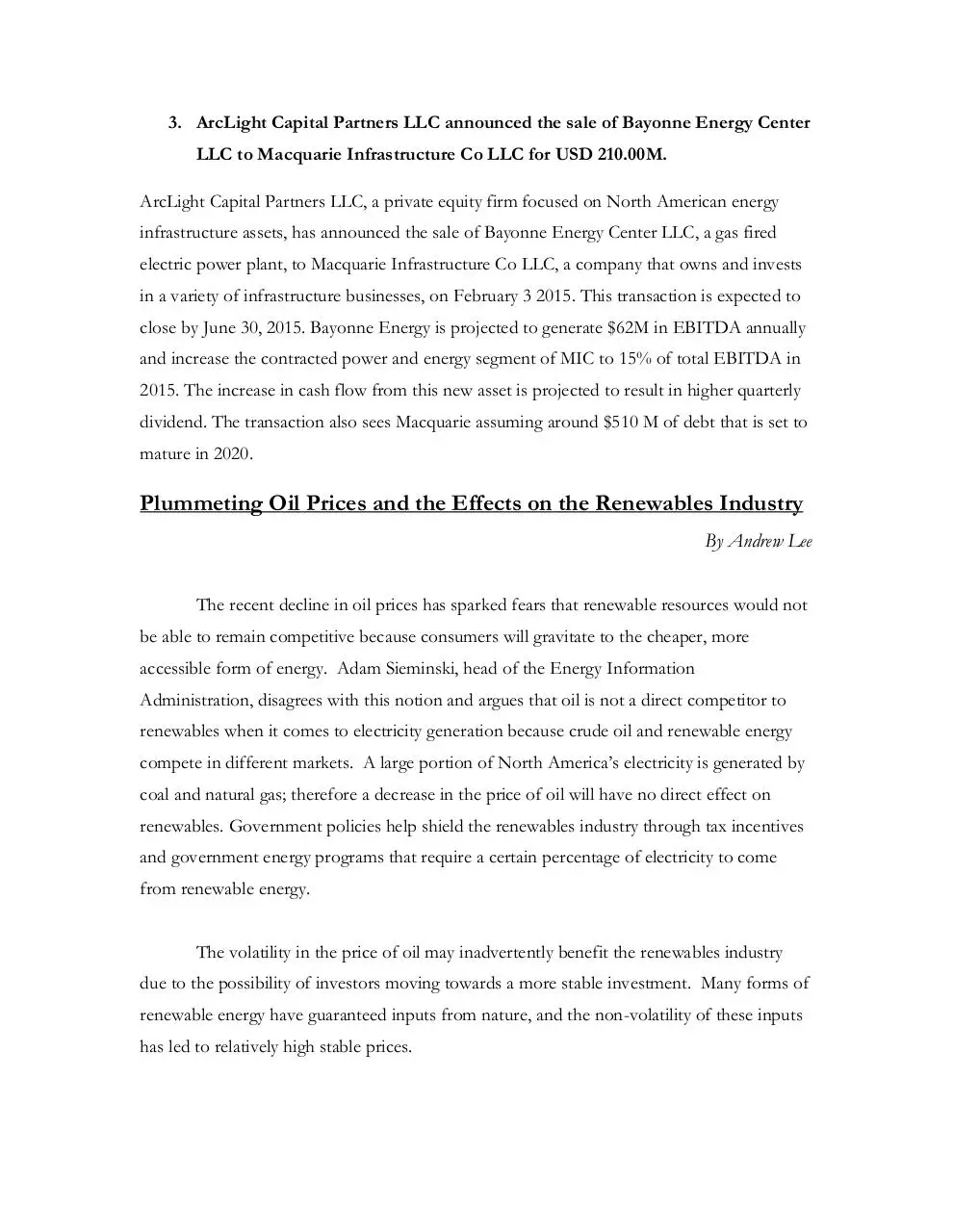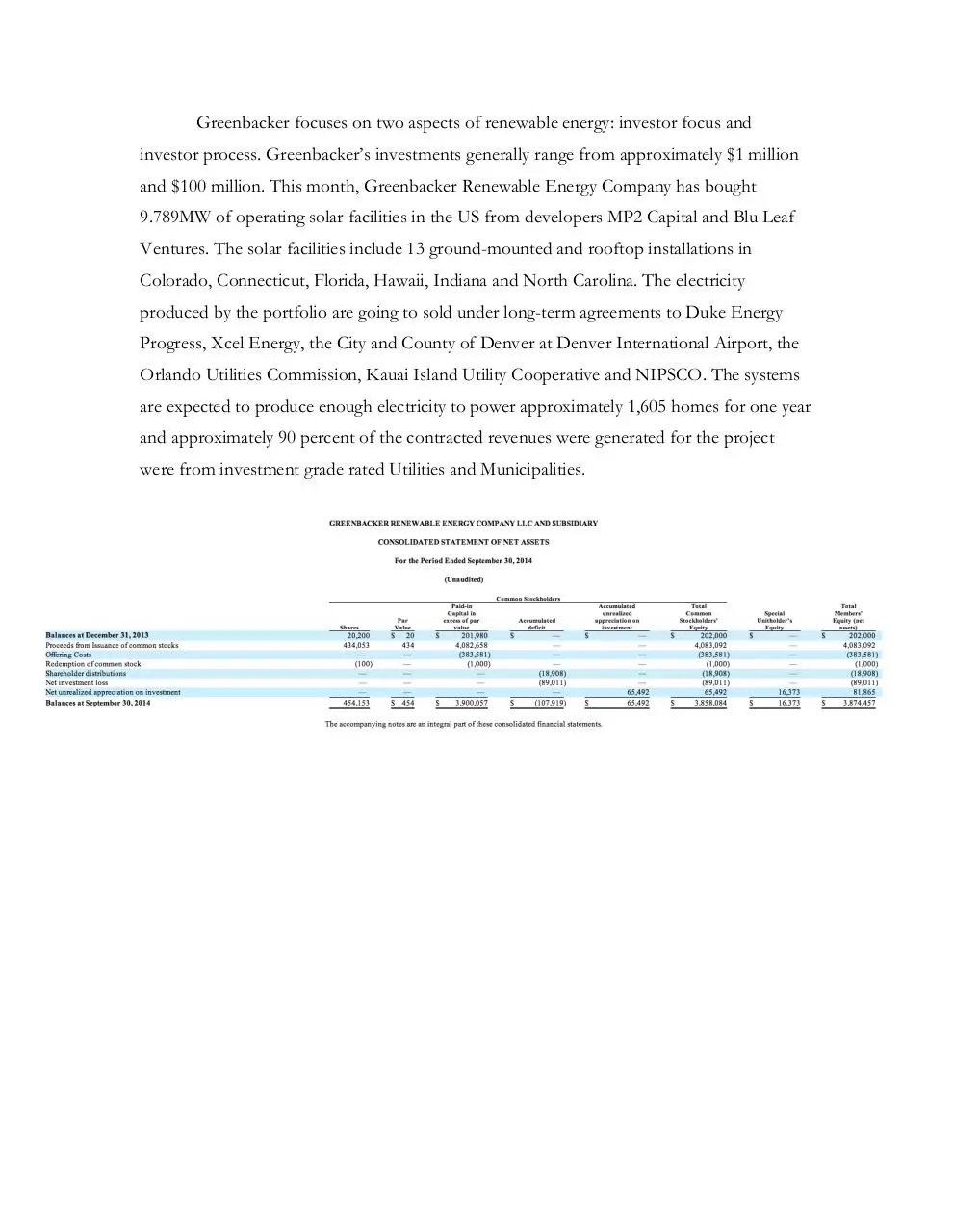Renewable and Nuclear Mailout (PDF)
File information
Author: Stephen Oosterbaan
This PDF 1.5 document has been generated by Microsoft® Word 2013, and has been sent on pdf-archive.com on 02/03/2015 at 04:23, from IP address 129.100.x.x.
The current document download page has been viewed 1484 times.
File size: 169.46 KB (4 pages).
Privacy: public file




File preview
IERC Renewable and Nuclear Newsletter
Recent Deals
By Katie Lawrence
1. SunEdison Inc completed the sale of 21 US distributed generation solar power
plants to TerraForm Power Inc for $47.00M USD
On January 8, 2015, SunEdison Inc, a global solar technology manufacturer and solar energy
services provider completed a transaction with TerraForm Power Inc an operator of clean
energy power plants. SunEdison, has purchased new wind turbines which will provide 1.6
gigawatts of wind energy projects along with U.S. federal production tax credit, and
TerraForm will be purchasing these projects once they achieve commercial operation. These
wind projects are from SunEdison’s acquisition of First Wind. The addition of 1.6 GW of
wind energy will further TerraForm as one of the leading renewable energy asset owner in
the world. Changes in regulatory requirements and renewable production incentives as well
as the seasonality of the industry provide risks for this transaction.
2. Sharp Corp of Japan announced that it has decided to transfer all interests in
Recurrent Energy LLC to Canadian Solar Inc. for $265 M USD.
On February 3 2015, Sharp Corp announced the sale of its North American unit Recurrent
Energy to Canadian Solar Inco. Canadian Solar is a company that designs and builds solar
projects, starting in 2010. The cross boarder company takeover includes seven late-stage U.S.
solar projects with a total of 1 gigawatt of capacity. The deal is scheduled to complete before
the investment tax credit is cut from 30% to 10% by the end of 2016. This transaction
supports its current projects in Canada, Japan, U.K, China, and South America. The deal
illustrated an industry trend towards downstream development activities, in line with
industry peers. The transaction is happening for $265M USD in cash. The sale provides
significant growth potential for Canadian Solar.
3. ArcLight Capital Partners LLC announced the sale of Bayonne Energy Center
LLC to Macquarie Infrastructure Co LLC for USD 210.00M.
ArcLight Capital Partners LLC, a private equity firm focused on North American energy
infrastructure assets, has announced the sale of Bayonne Energy Center LLC, a gas fired
electric power plant, to Macquarie Infrastructure Co LLC, a company that owns and invests
in a variety of infrastructure businesses, on February 3 2015. This transaction is expected to
close by June 30, 2015. Bayonne Energy is projected to generate $62M in EBITDA annually
and increase the contracted power and energy segment of MIC to 15% of total EBITDA in
2015. The increase in cash flow from this new asset is projected to result in higher quarterly
dividend. The transaction also sees Macquarie assuming around $510 M of debt that is set to
mature in 2020.
Plummeting Oil Prices and the Effects on the Renewables Industry
By Andrew Lee
The recent decline in oil prices has sparked fears that renewable resources would not
be able to remain competitive because consumers will gravitate to the cheaper, more
accessible form of energy. Adam Sieminski, head of the Energy Information
Administration, disagrees with this notion and argues that oil is not a direct competitor to
renewables when it comes to electricity generation because crude oil and renewable energy
compete in different markets. A large portion of North America’s electricity is generated by
coal and natural gas; therefore a decrease in the price of oil will have no direct effect on
renewables. Government policies help shield the renewables industry through tax incentives
and government energy programs that require a certain percentage of electricity to come
from renewable energy.
The volatility in the price of oil may inadvertently benefit the renewables industry
due to the possibility of investors moving towards a more stable investment. Many forms of
renewable energy have guaranteed inputs from nature, and the non-volatility of these inputs
has led to relatively high stable prices.
Dynamic Tidal Power – Fuelling China’s Growth
By Andrew Lee
China is the world’s largest energy consumer. The country relies heavily on coal and
hydropower resources; however, more recently, the government has been searching for local
renewable energy solutions in order to satiate the growing energy demand. Dynamic Tidal
Power (DTP) is a new method of power generation that converts the oscillating motion of
tidal waves into storable energy.
Concurrent research between China and a global
infrastructure design and consulting firm, ARCADIS, is developing this new technology and
researching the potential feasibility of tidal power facilities on China’s Eastern and Southern
sea borders. A single tidal power facility will produce 5000MW of capacity, the equivalent of
six large coal or gas power stations, or 10 million homes. The total amount of theoretical
DTP power in China is 80-150 GW, accounting for a significant part of China’s estimated
400GW hydropower capacity.
Featured Company: Greenbacker Renewable Energy Company
By Harrison Reilly
Greenbacker Renewable Energy Company (“Greenbacker”) is a clean and
renewables energy investment and transaction company, with 100 years of combined
experience in sourcing, constructing acquiring, and financing and operating energy
investments. Greenbacker is managed by Franklin Park Holdings; a firm that focuses on
investments in the global power and utility sector and has developed, invested in, and
managed power projects in the U.S., Asia and Latin America. Greenbacker acts as a center
point, by which a pool of investors’ capital is used to acquire and monitor a diversified
portfolio of income-producing renewable energy power plants, energy efficiency projects
and other sustainable development projects.
Greenbacker focuses on two aspects of renewable energy: investor focus and
investor process. Greenbacker’s investments generally range from approximately $1 million
and $100 million. This month, Greenbacker Renewable Energy Company has bought
9.789MW of operating solar facilities in the US from developers MP2 Capital and Blu Leaf
Ventures. The solar facilities include 13 ground-mounted and rooftop installations in
Colorado, Connecticut, Florida, Hawaii, Indiana and North Carolina. The electricity
produced by the portfolio are going to sold under long-term agreements to Duke Energy
Progress, Xcel Energy, the City and County of Denver at Denver International Airport, the
Orlando Utilities Commission, Kauai Island Utility Cooperative and NIPSCO. The systems
are expected to produce enough electricity to power approximately 1,605 homes for one year
and approximately 90 percent of the contracted revenues were generated for the project
were from investment grade rated Utilities and Municipalities.
Download Renewable-and-Nuclear-Mailout
Renewable-and-Nuclear-Mailout.pdf (PDF, 169.46 KB)
Download PDF
Share this file on social networks
Link to this page
Permanent link
Use the permanent link to the download page to share your document on Facebook, Twitter, LinkedIn, or directly with a contact by e-Mail, Messenger, Whatsapp, Line..
Short link
Use the short link to share your document on Twitter or by text message (SMS)
HTML Code
Copy the following HTML code to share your document on a Website or Blog
QR Code to this page

This file has been shared publicly by a user of PDF Archive.
Document ID: 0000212068.